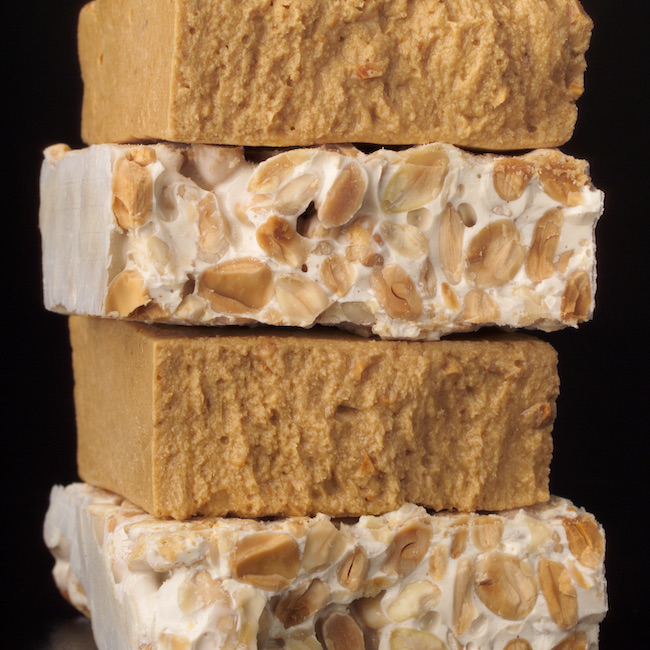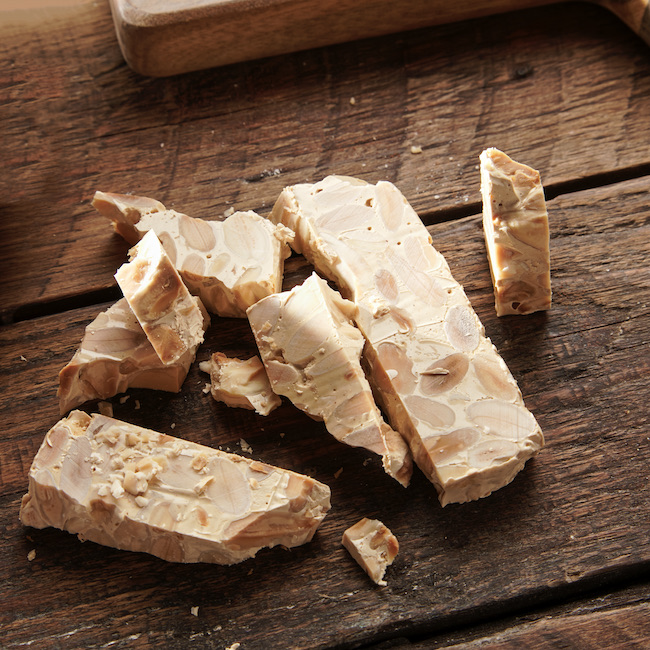by Graham Keeley - @grahamkeeley
.png.transform/rendition-xs/image_image%20(1).png)
This traditional Christmas Sweet is increasingly becoming an all-year round delicacy and also a versatile ingredient for the best Spanish chefs

by Graham Keeley - @grahamkeeley
For any Spaniards with a sweet tooth, turrón is as much a part of Christmas as the Three Kings or the roscón de Reyes, the sweet cake which families devour to celebrate the Epiphany – hoping to win a king hidden inside the cake rather than the booby prize of a bean.
But increasingly, makers of this essentially Spanish dessert are broadening its appeal beyond Christmas to make it something which is enjoyed throughout the year. Fabián López Coloma, owner of www.turronesydulces.com, an online shop which prides itself on selling this sweet treat “all year round”. “Some people want to buy turrón to take on a plane so that they can give somebody something that is typically Spanish as a present,” he said. “Spaniards who are living around the world like turrón at any time because they might get nostalgic about home.”
Known beyond Spain as nougat, it is typically made of honey, sugar, and egg white with toasted almonds or, in some cases, other nuts.Turrón is popular not just within Spain but in Latin America and among Spanish expatriate communities dotted around Europe, United Kingdom and in some cities in United States as Miami and New York.

A bit of history
The confection of turrón dates to the 16th century when the first record of turrón appeared in the Manual de Mujeres (Women’s Handbook), a book which included not just recipes for food but make-up. According to this recipe, turrón should be made with egg whites and honey which are cooked until the mixture becomes brittle when it cools down. The recipe also suggests adding some pine nuts, almonds or hazelnuts which should be peeled and then roasted.
The mix is cooked a bit more and finally removed from the heat and cut into slices. Turrón and its alternative versions in Italy, France and Greece, gets its name from the Latin word torrere (to toast). Theories abound but the modern recipe may be derived from a Muslim recipe which existed in parts of Spain when the country was under Muslim rule for hundreds of years. Jijona, a town near Alicante in southeastern Spain, is the birthplace of turrón in Spain and it is claimed it was first cooked there in the 15th century.
Different types of turrón come from different places. The hard version – called duro in Spanish – was named after Alicante. This is normally made of a compact block of whole almonds and can be hard to break up. In contrast, the soft variety is made by reducing the almonds to a paste. This turrón blando has a much more mushy and crumbly consistency. To broaden its appeal, turroneros or turroneras- as the makers of this confectionery are called- have introduced other ingredients like black and white chocolate, lemon, and other fruits.

A taste of Spain
Ana Picó is the quality controller of Turrones Picó, one of the oldest turrón makers in Spain, which is based in Jijona, a small town of nearly 7,000 people, on the southeastern coast. The family started the business in the 1920s.
Through a historical quirk Jijona has the highest number of turroneros – turrón makers – in the world. “Generally, turrón is consumed during the Christmas period which is because of the almond harvest which is in August and September,” said Picó. “It is true that during the rest of the year you can find turrón in certain tourist areas or it is made into ice cream which is becoming popular.”
She said turrón is exported around the world to give consumers a taste of Spain. “We send a small amount to Miami, New York to Cuba or Mexico or Venezuela. Also, to France, a little bit in Germany and Britain. It is something typically Spanish,” Ms Picó said.
“Increasingly North African countries are importing turrón because they like sweet things. Of course, I would like to sell it outside of these markets.” Ms Picó said that other turrón makers have sold the desert in Australia, Britain, and other parts of the world.

A dish made with turrón and foie by Chef Susi Díaz.
An ingredient for surprising dishes
Chefs are increasingly using turrón to give a sweeter taste to popular dishes throughout the year. At the Rias Kru restaurant in Barcelona, chef Rafa Erbs makes a popular dessert called torrija. He combines almond ice cream with turrón as a base. It has proved so popular that he cannot afford to take it off the menu.
He is by far alone. It seems turrón is increasingly used by chefs to give a touch of sweetness not just to make dessert dishes. The chef Carles Abellán worked with Ferran Adrià, whose elBulli restaurant on the Costa Brava was voted the best in the world five times by Restaurant magazine.
He made his own name with his concept restaurant Comerç 24 in Barcelona. His latest venture is Casa Natalia in Formentera, the fashionable island next to Ibiza. “I use turrón to give a sweet touch to my dish fricandó de ternera, a typical Catalan dish with veal,” he said. “I add the turrón when the veal is very tender. It is very popular with diners at my restaurant.”
And when it comes to use turrón in non-dessert recipes there is nobody better than Chef Susi Díaz -1 Michelin star, La Finca restaurant (Elche, Alicante)-. In order to explore the possibilities of using turrón she has presented dishes as a duck liver and turrón de Jijona with hints of pepper, salt and mushroom powder bonbon. Díaz has highlighted “turrón de Jijona is such a valuable ingredient in the kitchen” that “fits perfectly in a lot of recipes” so “it is a such a shame that its consumption is limited to Christmas time.”
It is clear that turrón is becoming an all-year round favorite that can be enjoyed on its own or as an (important) ingredient in chef’s recipes.